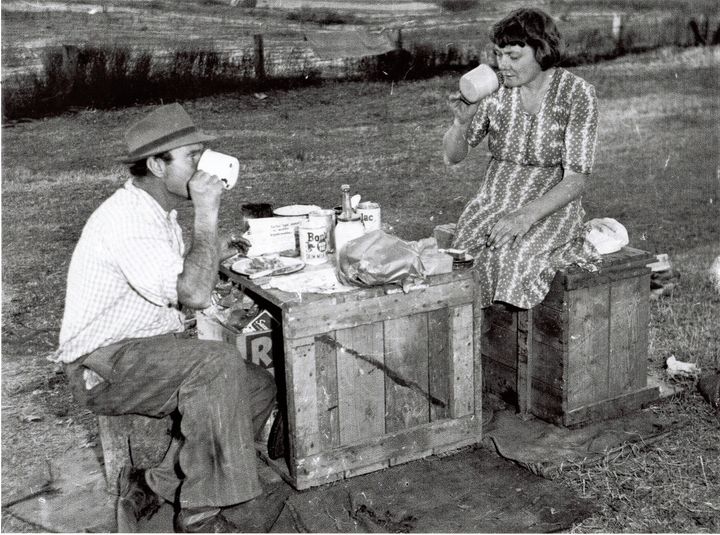
An unknown couple eating their humble meal in their makeshift dining room in the mid-20th century. Photo: Museum of the Riverina.
Today, the Museum of the Riverina takes us back to the middle of last century and a photo of a couple making the most of what little they had.
From the earliest days of European settlement (and naturally, before that) people have found shelter on the reserves and open spaces that encircle Wagga.
This photograph, dating to the late 1950s-early ’60s, shows a couple who have made their temporary home on one of Wagga’s reserves, possibly the North Wagga Flats.
Their makeshift dining room comprises hessian sacks for carpets and wooden packing cases for their table and chairs.
They drink from enamel mugs, and their fresh food is packaged in greaseproof paper.
They may be ”new Australians” who emigrated from their homeland following World War II.
Unfortunately, we do not know anything for sure.
In the early 1860s, 100 years before this photo was taken, ”unlicensed squatters” were known to illegally occupy the Crown Lands of Wagga.
In June 1863, the Wagga Wagga Express reported that those living in tents and other habitations were being ”rigorously ejected”, having been given immediate notice from the Crown lands ranger to ”skedaddle within 14 days”.
In August 1911, Alderman Edward Easter Collins expressed concerns about people living on Wagga’s reserves, including those on the north and south sides of the Hampden Bridge.
The south side of the river was more populated, mostly by age pensioners, with accommodation ranging from crude cabins made of iron, wood and canvas to tents made of bags.
Sanitary inspector W A Gibbs was duly dispatched to inspect the dwellings to record the cleanliness of the sites and assess the moral climate.
Mr Gibbs’ report reads: “Old age pensioner, living alone in tent, has been there over five years, works casually in local dairy, camp clean and well kept.
“Old age pensioner, camped in hollow log, has been there some years, camp clean.
“Old age pensioner, living in rough cabin, has been there some years, camp clean and well kept.
“Man, wife, daughter (11) and son (7), living in tent divided to form two sleeping apartments, were turned out of house five months ago when it changed ownership, have been unable to obtain accommodation, man is away carting all day, camp is fairly clean and well kept, sanitary arrangements satisfactory.”
Among the inhabitants was a married couple, described as “Hindoo”, whose home was a ”bagging shanty”, and they kept a horse and wagon.







